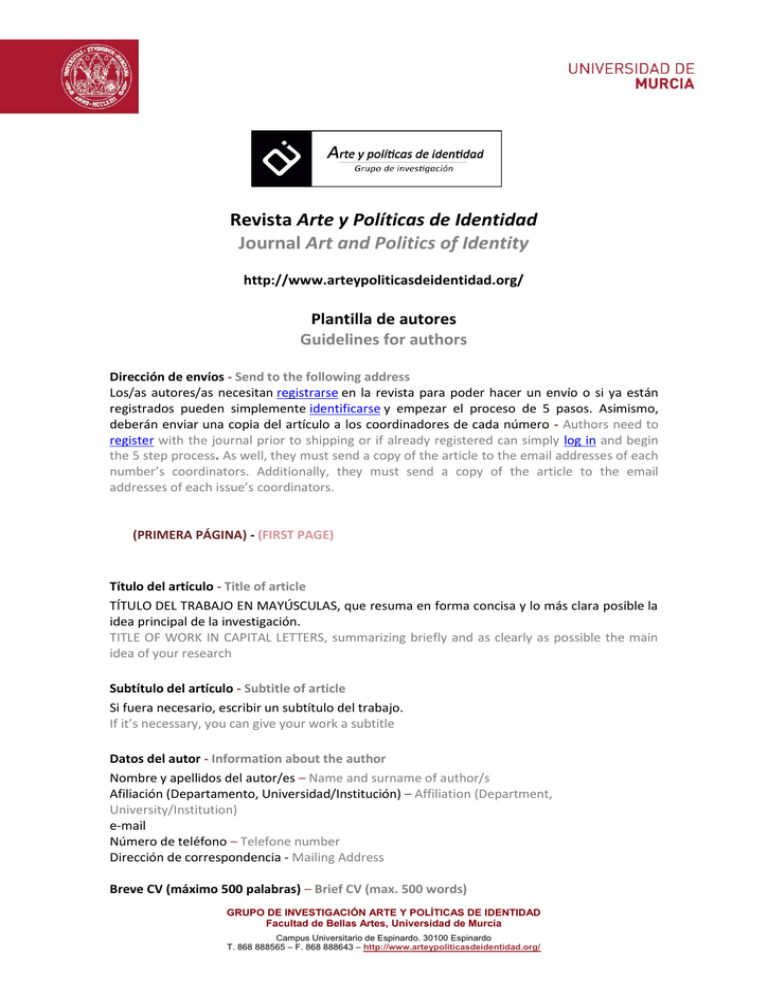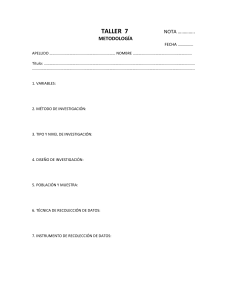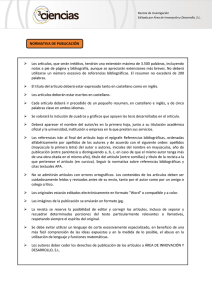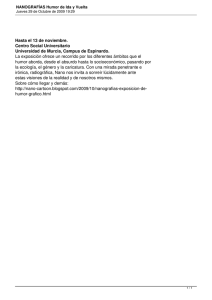Revista Arte y Políticas de Identidad Journal Art and Politics of Identity
Anuncio

Revista Arte y Políticas de Identidad Journal Art and Politics of Identity http://www.arteypoliticasdeidentidad.org/ Plantilla de autores Guidelines for authors Dirección de envíos - Send to the following address Los/as autores/as necesitan registrarse en la revista para poder hacer un envío o si ya están registrados pueden simplemente identificarse y empezar el proceso de 5 pasos. Asimismo, deberán enviar una copia del artículo a los coordinadores de cada número - Authors need to register with the journal prior to shipping or if already registered can simply log in and begin the 5 step process. As well, they must send a copy of the article to the email addresses of each number’s coordinators. Additionally, they must send a copy of the article to the email addresses of each issue’s coordinators. (PRIMERA PÁGINA) - (FIRST PAGE) Título del artículo - Title of article TÍTULO DEL TRABAJO EN MAYÚSCULAS, que resuma en forma concisa y lo más clara posible la idea principal de la investigación. TITLE OF WORK IN CAPITAL LETTERS, summarizing briefly and as clearly as possible the main idea of your research Subtítulo del artículo - Subtitle of article Si fuera necesario, escribir un subtítulo del trabajo. If it’s necessary, you can give your work a subtitle Datos del autor - Information about the author Nombre y apellidos del autor/es – Name and surname of author/s Afiliación (Departamento, Universidad/Institución) – Affiliation (Department, University/Institution) e-mail Número de teléfono – Telefone number Dirección de correspondencia - Mailing Address Breve CV (máximo 500 palabras) – Brief CV (max. 500 words) GRUPO DE INVESTIGACIÓN ARTE Y POLÍTICAS DE IDENTIDAD Facultad de Bellas Artes, Universidad de Murcia Campus Universitario de Espinardo. 30100 Espinardo T. 868 888565 – F. 868 888643 – http://www.arteypoliticasdeidentidad.org/ (SEGUNDA PÁGINA) - (SECOND PAGE) Título del artículo tanto en español como en inglés, así como en el idioma del artículo si no fuera ninguno de estos dos - Title of article in Spanish and English as well as in the original language of the article (if different) TÍTULO DEL TRABAJO EN MAYÚSCULAS, que resuma en forma concisa y lo más clara posible la idea principal de la investigación. TITLE OF WORK IN CAPITAL LETTERS, summarizing briefly and as clearly as possible the main idea of your research. Subtítulo del artículo, tanto en español como en inglés así como en el idioma del artículo si no fuera ninguno de estos dos - Subtitle of article in Spanish and English as well as in the original language of the article (if different) Si fuera necesario, escribir un subtítulo del trabajo If it’s necessary, you can give your work a subtitle Resumen tanto en castellano como en inglés, así como en el idioma del artículo si no fuera ninguno de los dos anteriores (máximo 200 palabras) – Abstract in Spanish and English as well as in the original language of the article (if different) (max. 200 words) Es una síntesis del artículo, debe ofrecer un sumario breve de cada uno de los apartados del texto; se recomienda redactarlo en un único párrafo. Debe indicar los objetivos principales y el alcance de la investigación, describir los métodos y materiales empleados, resumir los resultados y enunciar las conclusiones principales. No debe presentar ninguna información y conclusión que no figure en artículo, y tampoco deben citarse las referencias bibliográficas. This is a synthesis of the article. It must offer a brief summary of each one of the sections of the text; it is advisable to compose it in one paragraph. It should indicate the main objectives and the end goal of the research, describing the methods and materials that were used, summarizing the results and formulating the main conclusions. It should not present any information and conclusion that does not appear in the article, and it should not either cite bibliographical references. Palabras clave (entre 4 y 8) – Keywords (between 4 and 8) Xxxxxxx, xxxxxx, xxxxxxxxxxxxxxx, xxxxxxxxxxxxxxx, xxxxxxxxxx GRUPO DE INVESTIGACIÓN ARTE Y POLÍTICAS DE IDENTIDAD Facultad de Bellas Artes, Universidad de Murcia Campus Universitario de Espinardo. 30100 Espinardo T. 868 888565 – F. 868 888643 – http://www.arteypoliticasdeidentidad.org/ (A PARTIR DE LA TERCERA PÁGINA) - (FROM THIRD PAGE ON) Texto del artículo (estilo normal) – Text of article (normal style) Aquí comienza el texto del artículo. Debe emplearse un estilo de redacción claro y conciso. Se utilizará como fuente Arial (11) o Times New Roman (12), interlineado sencillo y alineación justificada. Entre párrafo y párrafo se dejará un espacio y dos entre apartados. La extensión del artículo oscilará entre 12 y 20 páginas (mínimo 3000 palabras y máximo 7000) incluidas las imágenes (máximo 10). Recuerde que cuando cite el título de algún libro, exposición u obra estos deberán ir en cursiva. Here the text of the article starts. The author needs to use a clear and concise style of writing. The font will be Arial (11) or Times New Roman (12), single line and justified. Between paragraphs it is necessary to leave a line and two between sections. The extension of the article will be between 12 and 20 pages (min. 3000 words and max. 7000) including images (max. 10). Remember that when citing the title of a book, an exhibition or work, these should go in italics. Los trabajos de investigación deben estructurarse en los siguientes apartados: Introducción, Método, Resultados, Discusión/Conclusiones y Referencias; y los de Revisión Teórica en: Planteamiento del problema (normalmente es el apartado "Introducción"), Desarrollo del tema (con los apartados específicos que correspondan según los contenidos desarrollados), Discusión y/o Conclusiones y Referencias. The Research works should be structured in the following sections: Introduction, Methods, Results, Discussion/Conclusion and References; and the Theoretical Review works in: Approach to the problem (normally it is the section called “Introduction”), Development of the topic (with the specific sections corresponding to the content developed), Discussion and/or Conclusions and References. Títulos por nivel - Titles according to levels of headings Si se utilizan niveles de títulos serán los siguientes: If different levels of headings are used it would be as following: Título Primer nivel (12p) - Title of First Heading (12p) Título a la izquierda y en negrita. Con texto en nuevo párrafo, sin tabulación inicial. Title on the left and bold. With text in new paragraph without indentation. GRUPO DE INVESTIGACIÓN ARTE Y POLÍTICAS DE IDENTIDAD Facultad de Bellas Artes, Universidad de Murcia Campus Universitario de Espinardo. 30100 Espinardo T. 868 888565 – F. 868 888643 – http://www.arteypoliticasdeidentidad.org/ 1. Título Segundo nivel (12p) - Title of Subheading (Second level) (12p) Título a la izquierda en negrita y enumerado. Con texto en nuevo párrafo, sin tabulación inicial. Title on the left, bold and numbered. Título a la izquierda en negrita y enumerado. With text in new paragraph without indentation 1.1. Título Tercer nivel (12p) - Title of Subheading (Third level) (12p) Título a la izquierda, en negrita y enumerado. Con texto en nuevo párrafo, sin tabulación inicial. Title on the left, bold and numbered. With text in new paragraph without indentation Si dentro de alguno de los apartados tuviese que realizar una enumeración, utilice la fórmula a), b), c) etc. If within any of the sections, any kind of enumeration must be done, the following formula must be used: a), b), c), etc. En la redacción, evite usar adjetivos o pronombres específicos para los sexos. Así también deberán evitarse las asunciones derivadas de los estereotipos de género sobre la gente, sus habilidades, actitudes y relaciones. Los textos deben ser redactados en tercera persona, preferentemente en la voz impersonal, prefiriendo siempre “los autores consideran” o “se considera” sobre una sentencia como “nosotros creemos.” In the composition, avoid using specific gendered adjectives or pronouns. Additionally, assumptions based on gender stereotypes on people, skills, attitudes and relationships should also be avoided. Texts should be written in third person, preferably using an impersonal voice, preferring always the use of “the authors consider” or “it is considered” to a sentence such as “we believe.” Las ilustraciones - Illustrations Todas las ilustraciones y las fotografías se denominarán figuras y llevarán numeración arábiga correlativa, se ajustarán al texto y se centrarán. Las figuras se citarán en el texto (Fig. 1) y se acompañarán de un pie de figura. Cuando una figura conste de varios elementos independientes, cada uno de ellos se identificará por una letra mayúscula (Fig. 1A, B *referencia completa*). All the illustrations and the pictures will be called figures and they will have correlative Arabic numeration, will fit the text and will be centered. Figures will be cited in the text (Fig. 1) and will be accompanied by a caption. When a figure consists of several independent elements, each one of them will be identified by a capital letter (Fig. 1A, B *complete reference*). GRUPO DE INVESTIGACIÓN ARTE Y POLÍTICAS DE IDENTIDAD Facultad de Bellas Artes, Universidad de Murcia Campus Universitario de Espinardo. 30100 Espinardo T. 868 888565 – F. 868 888643 – http://www.arteypoliticasdeidentidad.org/ Figura 1 - Figure 1. Eugène Henri Paul Gauguin, Parau api (¿Qué hay de nuevo?), 1892. Óleo sobre lienzo, 67 x 91 cm. (Fuente: http://commons.wikimedia.org/wiki/File:Paul_Gauguin_144.jpg) (Procedencia y autor/fuente de la imagen utilizada) (Origin and author/source of the image being used) Las citas - Quotes En el texto todas las citas se adecuarán a las normas APA 4ª Edición o posterior (http://www.apastyle.org/; para ver versión en español consúltese el siguiente enlace http://portales.puj.edu.co/ftpcentroescritura/Recursos/Normasapa.pdf). In the text, all quotes will follow the norms APA 4th edition or subsequent (http://www.apastyle.org/; to see a Spanish version go to the following link http://portales.puj.edu.co/ftpcentroescritura/Recursos/Normasapa.pdf). Notas – Notes Las notas al pie de página solo se utilizarán para realizar aclaraciones o para añadir información extra. Footnotes will be used only to make clarifications or to add extra information. Referencias - References Las referencias irán al final por orden alfabético, y se adecuarán a las normas APA mencionadas anteriormente; no existirá separación entre libros, artículos, páginas webs etc. Solamente se incluirán aquellas obras a las que se haya aludido en el texto. A modo de ejemplo sirvan los siguientes: GRUPO DE INVESTIGACIÓN ARTE Y POLÍTICAS DE IDENTIDAD Facultad de Bellas Artes, Universidad de Murcia Campus Universitario de Espinardo. 30100 Espinardo T. 868 888565 – F. 868 888643 – http://www.arteypoliticasdeidentidad.org/ References will go at the end, alphabetically ordered and will follow norms APA mentioned before; there will not be separation between books, articles, webpages, etc. Only the works cited in the text will be included. See the following examples: Libros - Books: Apellido, A. A. (Año). Título. Ciudad: Editorial. Last Name, A. A. (Year). Title. City: Publishing House. Crick, F. (1994). La búsqueda científica del alma. Madrid: Debate. Wilber, K. (Ed.). (1997). El paradigma holográfico. Barcelona: Editorial Kairós Capítulos de libros - Book chapters: Apellido, A. (Año). Título del capítulo o la entrada. En A. A. Apellido. (Ed.), Título del libro (pp. xx-xx). Ciudad: Editorial. Last Name, A. (Year). Title of chapter. In A. A. Last Name. (Ed.), Title of book (pp. xx-xx). City: Publishing House. Alibali, M. W. (2005). Mechanisms of change in the development of mathematical reasoning. In R. V. Kail (Ed.), Advances in child development and behavior (pp. 79-123). New York: Academic Press. Artículos - Articles: Apellido, A. A., Apellido, B. B. & Apellido, C. C. (Fecha). Título del artículo. Nombre de la revista, Volume (número), pp-pp. Apellido, A. A., Apellido, B. B. & Apellido, C. C. (Date). Title of article. Name of Journal, Volume (number), pp-pp. Alibali, M. W. (1999). How children change their minds: Strategy change can be gradual or abrupt. Developmental Psychology, 35, 127-145. Anexos - Annexes Si los hubiere: Aquí se puede incluir todo lo que no sea conveniente poner en el texto. If there is any: here you can include everything that is not convenient to have within the text. Recibido: A rellenar por la redacción de la revista - Received: To fill out by the Journal editorial board Aprobado: A rellenar por la redacción de la revista - Approved: To fill out by the Journal editorial board GRUPO DE INVESTIGACIÓN ARTE Y POLÍTICAS DE IDENTIDAD Facultad de Bellas Artes, Universidad de Murcia Campus Universitario de Espinardo. 30100 Espinardo T. 868 888565 – F. 868 888643 – http://www.arteypoliticasdeidentidad.org/ CÓDIGO ÉTICO SOBRE PUBLICACIÓN Y DE BUENAS PRÁCTICAS La redacción de la revista Arte y Políticas de Identidad está comprometida con la comunidad científica para garantizar la ética y calidad de los artículos publicados. Nuestra revista tiene como referencia el Código de conducta y buenas prácticas http://publicationethics.org/files/Code_of_conduct_for_journal_editors.pdf que define el Comité de Ética en Publicaciones (COPE) para editores de revistas científicas. El Comité Editorial se compromete a publicar las correcciones, aclaraciones, retracciones y disculpas cuando sea preciso. Arte y Políticas de Identidad declara su compromiso por el respeto e integridad de los trabajos ya publicados. Por esta razón, el plagio está estrictamente prohibido y los textos que se identifiquen como plagio o su contenido sea fraudulento, serán eliminados de la revista si ya se hubieran publicado o no se publicarán. La revista actuará en estos casos con la mayor celeridad posible. Al aceptar los términos y acuerdos expresados por nuestra revista, los autores han de garantizar que el artículo y los materiales asociados a él son originales o no infringen los derechos de autor. También los autores tienen que justificar que, en caso de una autoría compartida, hubo un consenso pleno de todos los autores afectados y que no ha sido presentado ni publicado con anterioridad en otro medio de difusión. The editorial board of the journal Art and Identity Politics is committed to the scientific community in order to guarantee the ethics and quality of published articles. Our journal follows the guidelines established by the Code of conduct and good practices http://publicationethics.org/files/Code_of_conduct_for_journal_editors.pdf, created by the Committee of Ethics in Publications (COPE) for editors of scientific journals. The editorial board is committed to publish corrections, clarifications, retractions and apologies when it is necessary. Art and Identity Politics confirms its commitment towards the respect and integrity of already published works. Therefore, plagiarism is absolutely forbidden and the texts identified as plagiarized or whose content is found fraudulent will be eliminated from the journal, if they were already published, or will not be published. The journal will act as soon as possible in these cases. When agreeing with the terms and guidelines of our journal, authors must guarantee that the article and associated materials are original and that they avoid copyright infringement. Moreover, in the case of collaboration, authors must justify that there is a consensus among all the authors and that the article has not been presented nor published previously in another medium. GRUPO DE INVESTIGACIÓN ARTE Y POLÍTICAS DE IDENTIDAD Facultad de Bellas Artes, Universidad de Murcia Campus Universitario de Espinardo. 30100 Espinardo T. 868 888565 – F. 868 888643 – http://www.arteypoliticasdeidentidad.org/


![Concurso_halloween_2014-final30sep[2].pdf](http://s2.studylib.es/store/data/003925528_1-03082662331e7030a4e3165881c6b805-300x300.png)
